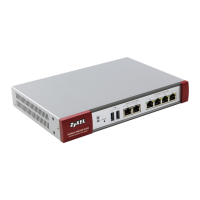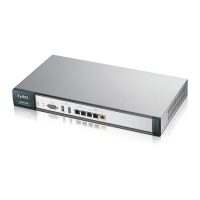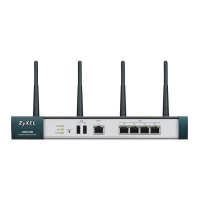Chapter 13 Interfaces
ZyWALL USG 100/200 Series User’s Guide
302
Each section in this screen is described below.
13.3 Ethernet Summary Screen
This screen lists every Ethernet interface and virtual interface created on top of
Ethernet interfaces. To access this screen, click Configuration > Network >
Interface.
Unlike other types of interfaces, you cannot create new Ethernet interfaces nor
can you delete any of them. If an Ethernet interface does not have any physical
ports assigned to it (see Section 13.2 on page 301), the Ethernet interface is
effectively removed from the ZyWALL, but you can still configure it.
Ethernet interfaces are similar to other types of interfaces in many ways. They
have an IP address, subnet mask, and gateway used to make routing decisions.
They restrict the amount of bandwidth and packet size. They can provide DHCP
services, and they can verify the gateway is available.
Use Ethernet interfaces to control which physical ports exchange routing
information with other routers and how much information is exchanged through
each one. The more routing information is exchanged, the more efficient the
routers should be. However, the routers also generate more network traffic, and
some routing protocols require a significant amount of configuration and
management. The ZyWALL supports two routing protocols, RIP and OSPF. See
Table 61 Configuration > Network > Interface > Port Role
LABEL DESCRIPTION
LAN1/WLAN/DMZ
PX~P7
These are physical Ethernet ports.
lan1 (LAN1)
lan2 (LAN2)
ext-wlan (WLAN)
dmz (DMZ)
These are Ethernet interfaces and the zone to which each belongs.
Use the radio buttons to select for which interface (network) you want
to use each physical port. For example, select a port’s LAN1 radio
button to use the port as part of the lan1 interface. The port will use
the ZyWALL’s lan1 IP address and MAC address.
When you assign more than one physical port to a network, you
create a port group. Port groups have the following characteristics:
• There is a layer-2 Ethernet switch between physical ports in the
port group. This provides wire-speed throughput but no security.
• It can increase the bandwidth between the port group and other
interfaces.
• The port group uses a single MAC address.
Apply Click this button to save your changes and apply them to the ZyWALL.
Reset Click this button to change the port groups to their current
configuration (last-saved values).

